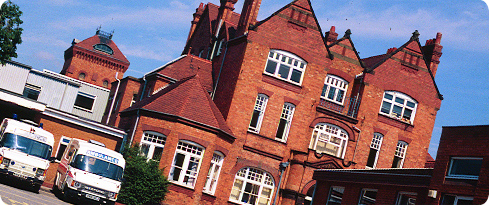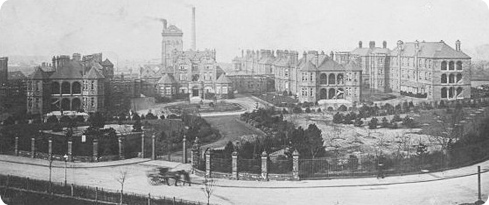Your views

Your feedback is vital to us as we continue to increase the quality of our services.
You are here:
Date: 22 February 2025
Time: 20:04

History of Selly Oak Hospital
Selly Oak Hospital's birth as an institution was not an event of national pride or cutting-edge medical innovation. Its remarkable story is one of gradual evolution from local poor law workhouse and infirmary to modern hospital treating complex cases of injury and disease. Through the history of one local institution we get a fascinating insight into aspects of the social and medical history of our country.
The first buildings on the site of Selly Oak Hospital were those of the King's Norton Union Workhouse, featured in the image below. It was a place for the care of the poor and was one of many workhouses constructed throughout the country following the introduction of the Poor Law Amendment Act of 1834. This act replaced the earlier system of poor relief, dating from 1601.

The rising costs of poor relief had become a national problem and the new act sought to address this. Throughout the country, parishes were formed into larger unions with the power to raise money from rates on property to pay for the poor. King's Norton Poor Law Union was formed from the parishes of Harborne, Edgbaston, King's Norton, Northfield and Beoley. Each of these five parishes had individual workhouses.
These were replaced in 1872 by the new, much larger one at Selly Oak. It was built to accommodate 200 pauper inmates. Central supervision by the Poor Law Commissioners in London ensured that all workhouses were administered similarly by a set of rules and regulations. How humanely these were interpreted depended entirely upon each local board of poor law guardians, who were local worthies. They were elected annually and gave their services voluntarily.
The aim of the Poor Law Amendment Act was to deny any form of relief except through admission to the workhouse. Generally it was assumed that the able-bodied poor could find work and if they didn't then they should be forced to work within the confines of the workhouse. It was thought that if conditions in the workhouse were really bad then the poor would be deterred from seeking relief. However, by the late 18th century it became apparent that the majority of workhouse inmates were the most vulnerable people in society; the young, the old, the chronically sick and the mentally ill. Various Acts of Parliament ruled that separate provision should be made for children and the mentally ill. The sick poor were to be accommodated in separate infirmary blocks. These were often built adjacent to the workhouses and were the forerunners of many great hospitals of today.
At Selly Oak, a separate infirmary was built in 1897 at a cost of £52,000. It was the subject of much heated debate as the original estimate had been £18,000. It was a light, clean and practical building, and generally a source of much pride. The guardians took great care and gathered information from other infirmaries to ensure that the final design, put out to a competition and won by Mr. Daniel Arkell, was up-to-date and modern.
The infirmary accommodated about 250 patients in eight Nightingale wards and smaller side wards and rooms. There was also provision for maternity cases. Between the two main pavilions were a central administration block, kitchens, a laundry, a water tower, doctors' rooms and a telephone exchange. There was no operating theatre or mortuary and, in the workhouse tradition, the internal walls were not plastered, painted brick being considered good enough for the sick paupers. The workhouse and infirmary were separated by a high dividing wall and were run as separate establishments.
The population of the King's Norton Union increased dramatically, and in 1907 extensions to the infirmary and the workhouse made provision for the growing numbers of poor people. This doubled the size of the main hospital building. The Woodlands Nurses' Home was built at the same time to accommodate forty nurses. A small operating room was added to the infirmary. The map below shows the development of the Selly Oak site from 1884 to 1916.

There was a resident nursing staff of eight trained nurses and nineteen probationers who were supervised by the Matron. She also had responsibility for the resident female servants. The Steward managed the infirmary, governed the male servants, kept the accounts, ordered provisions, and recorded births and deaths. There was a Senior Medical Officer who attended three times a week between 11:00 and 13:00. A Resident Medical Officer attended at both the infirmary and the workhouse.
In 1911, King's Norton – no longer a rural area – left Worcestershire and became part of the City of Birmingham. The Birmingham Union was formed from the unions of King's Norton, Aston and Birmingham. The King's Norton Workhouse Infirmary was renamed Selly Oak Hospital.
Over the next two decades, facilities improved with the addition of an operating theatre, plastering of internal walls, and the introduction of physiotherapy, pathological and X-ray services. By 1929 there were seven full-time members of the medical staff, and the medical residence was built at this time.
Attitudes to the poor changed gradually and measures to relieve poverty, such as old age pensions and National Insurance, were introduced before the First World War. By 1930, the administrative structure of the Poor Law was finally dismantled. Selly Oak Hospital and the workhouse, renamed Selly Oak House, came under the administration of Birmingham City Council. Selly Oak House was administered separately and used for the care of the elderly chronically sick.
Selly Oak Hospital continued to grow, new operating theatres were added in 1931, and the biochemistry and pathology laboratories opened in 1934. Nurses had been trained at Selly Oak since 1897, but it wasn't until 1942 that the School of Nursing was opened.
In 1948, when the National Health Service was introduced, Selly Oak Hospital and Selly Oak House were amalgamated. Since then many changes to the site have resulted in the institution we see today. The image below shows an aerial view of Selly Oak Hospital in 1952.

By Valerie Richards
Valerie Richards (formerly Arthur) worked as a rheumatology nurse specialist at Selly Oak Hospital before retiring some years ago. She is the author of a forthcoming book on the history of Selly Oak Hospital.
Related pages

Getting here
Information about travelling to, staying at and getting around the hospital.

Jobs at UHB
A great place to work. Learn why.


